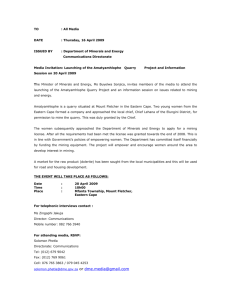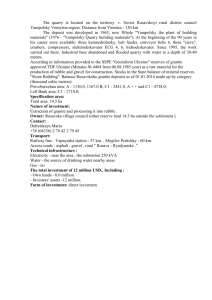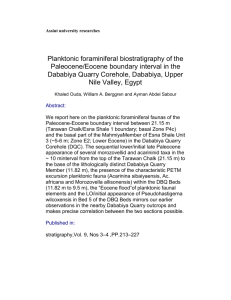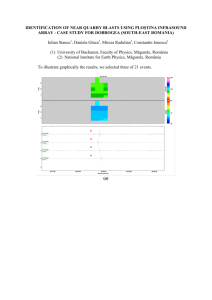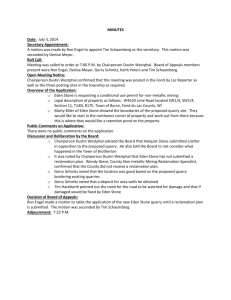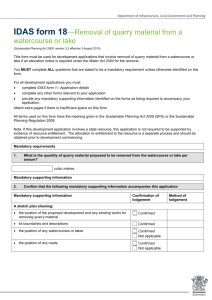Biodiversity and Educational Trails on
advertisement
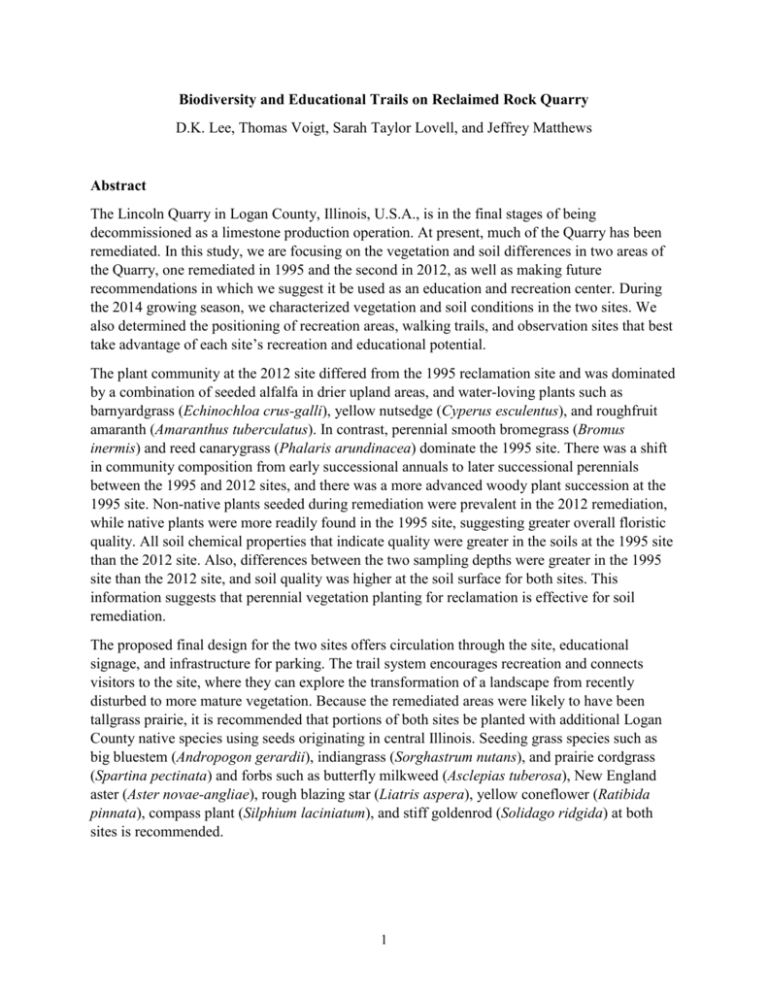
Biodiversity and Educational Trails on Reclaimed Rock Quarry D.K. Lee, Thomas Voigt, Sarah Taylor Lovell, and Jeffrey Matthews Abstract The Lincoln Quarry in Logan County, Illinois, U.S.A., is in the final stages of being decommissioned as a limestone production operation. At present, much of the Quarry has been remediated. In this study, we are focusing on the vegetation and soil differences in two areas of the Quarry, one remediated in 1995 and the second in 2012, as well as making future recommendations in which we suggest it be used as an education and recreation center. During the 2014 growing season, we characterized vegetation and soil conditions in the two sites. We also determined the positioning of recreation areas, walking trails, and observation sites that best take advantage of each site’s recreation and educational potential. The plant community at the 2012 site differed from the 1995 reclamation site and was dominated by a combination of seeded alfalfa in drier upland areas, and water-loving plants such as barnyardgrass (Echinochloa crus-galli), yellow nutsedge (Cyperus esculentus), and roughfruit amaranth (Amaranthus tuberculatus). In contrast, perennial smooth bromegrass (Bromus inermis) and reed canarygrass (Phalaris arundinacea) dominate the 1995 site. There was a shift in community composition from early successional annuals to later successional perennials between the 1995 and 2012 sites, and there was a more advanced woody plant succession at the 1995 site. Non-native plants seeded during remediation were prevalent in the 2012 remediation, while native plants were more readily found in the 1995 site, suggesting greater overall floristic quality. All soil chemical properties that indicate quality were greater in the soils at the 1995 site than the 2012 site. Also, differences between the two sampling depths were greater in the 1995 site than the 2012 site, and soil quality was higher at the soil surface for both sites. This information suggests that perennial vegetation planting for reclamation is effective for soil remediation. The proposed final design for the two sites offers circulation through the site, educational signage, and infrastructure for parking. The trail system encourages recreation and connects visitors to the site, where they can explore the transformation of a landscape from recently disturbed to more mature vegetation. Because the remediated areas were likely to have been tallgrass prairie, it is recommended that portions of both sites be planted with additional Logan County native species using seeds originating in central Illinois. Seeding grass species such as big bluestem (Andropogon gerardii), indiangrass (Sorghastrum nutans), and prairie cordgrass (Spartina pectinata) and forbs such as butterfly milkweed (Asclepias tuberosa), New England aster (Aster novae-angliae), rough blazing star (Liatris aspera), yellow coneflower (Ratibida pinnata), compass plant (Silphium laciniatum), and stiff goldenrod (Solidago ridgida) at both sites is recommended. 1 Introduction During the 1800s, central North American grasslands, tallgrass prairies, were often converted to cultivated annual row crops, leaving only small prairie remnants around the edges of farmlands. The conversion of tallgrass prairie to agricultural lands resulted in dramatic changes in plant communities. In Illinois, U.S.A., some sites have been further modified to extract large deposits of accessible limestone through quarrying. In these areas, significant impacts on land cover, ecosystems, and biodiversity usually occurred. Traditionally, the non-coal mining industry in Illinois completed reclamation obligations with little consideration of local or regional needs, since the state’s reclamation requirements are limited to simply developing a permanent vegetative cover. Moreover, these lands are typically not returned to earlier uses due to poor soil structure and fertility, and are maintained as reclaimed land or sometimes used for recreation (Illinois Department of Natural Resources, 2014). Reclaiming quarried sites in areas that were presettlement grasslands offers an opportunity for prairie restoration, which can provide valuable refuges for native flora and fauna in regions of otherwise intensive commercial farming (Tropek et al., 2010). Many studies and field surveys have documented the conservation potential of reclaimed mining sites through restoring permanent vegetative cover and/or spontaneous succession (Wheater and Cullen, 1997; Krauss et al., 2009; Tropek et al., 2010; Gilardeli et al., 2013). Restoration of native prairie plant communities would support important ecosystem functions including biodiversity conservation and wildlife habitat, while also offering opportunities for visitors to engage with the landscape and learn about historical vegetation. In this work, we focus on two reclaimed, limestone-mined sites at the Lincoln Quarry in central Illinois, a region where intensive agriculture and urban areas cover more than 95% of county land. Species-enriched reclaimed quarry land provides an excellent habitat for wildlife and could be utilized as a recreational and educational space for the local community. However, the value of the reclaimed quarry land depends on the diversity of plant communities that exist following reclamation. Objectives This project was designed to understand plant community development the Lincoln Quarry by comparing intentionally planted and spontaneously colonizing plant species between two sites that differed in years since reclamation, and to provide educational walking trails that allow visitors to experience the biodiversity within, and the evolution of, the different plant communities. The specific objectives were to: 1) characterize the composition and diversity of plant species and communities in sites reclaimed in 1995 and 2012, 2) evaluate the historical changes in plant communities and the soil physical and chemical properties that have occurred between the two sites, and 3) design a system of walking trails that takes advantage of the evolving landscapes and includes educational stops and observation points on the two sites. 2 Background information Lincoln Quarry is located in Logan County, Illinois (40.125553, -89.466669). The site consists of an inactive limestone mining operation on approximately 300 hectares (745 acres) with 122 hectares (300 acres) of open water. The quarry completed limestone removal in spring 2011, and reclamation activities were completed a year later. Figure 1 shows the historical landscape transformation of the Lincoln Quarry from 1995 to 2014. After the limestone was mined out, all land area except the area of open water was graded and seeded according to the Illinois Department of Natural Resource’s Mine and Minerals Land Reclamation permit which requires that each acre be planted to a seed mixture of 3.0 – 4.5 kg (7-10 lbs.) of inoculated alfalfa (Medicago sativa), 1.4 – 2.3 kg (3-5 lbs.) of lespedeza (Lespedeza spp.), and 2.3 – 3.0 kg (5-7 lbs.) of smooth bromegrass (Bromus inermis). The 2012 seeding included this seed mix plus 2.0 kg (4.5 lbs.) of red top (Agrostis alba). Three main reclamations were completed in 1995, 1997, and 2012, respectively (Figure 2). The 1997 site was reclaimed with more native warm-season grasses with heavy seeding rates. For this reason, our current study was focused on plant community surveys on 1995 and 2012 sites to determine changes in plant communities based on reclamation timeline with similar species. Also these two sites provide an opportunity to develop educational walking trails, since the two contrasting plant communities are close to one another. Methods In order to become familiar with the landscape and vegetation cover, our first Quarry visit occurred in May 2014. Based on this survey, two research sites with contrasting reclamation histories and plant communities were selected for our research. During summer 2014, we established three standardized plots (40-m x 50-m) in each of two sites at the Lincoln Quarry, one reclaimed in 1995 and another reclaimed in 2012. We sampled plant species using the Illinois Critical Trends Assessment Protocol (Carroll et al. 2002) for wetland and grassland habitat (Figure 3). At each plot we recorded all vascular plants, with the exception of woody plants taller than 1 m, in 20, 0.25-m2 quadrats located along a single 40-m transect. We assigned each species a cover class (<1%, 1-5%, 6-25%, 26-50%, 51-75%, 76-95%, or 96-100%), which estimates the amount of area within the sample quadrat covered by that species (Daubenmire 1959). Additionally, we tallied all woody stems taller than 1 m and less than 5-cm diameter-atbreast-height (DBH) within a 4-m x 40-m plot placed along the transect (Figure 3). We measured DBH on all woody stems greater than 5-cm DBH within the 40-m x 50-m plot, and searched the entire plot for additional species not encountered in the quadrats. For each plot, we calculated eight vegetation-based indicators of restoration progress: total plant species richness; percent of perennial species; percent of native species; summed relative cover of perennial species; summed relative cover of native species; mean Coefficient of Conservatism; 3 shrub-stem density (stems m-2); and tree basal area (m2 ha-1). Coefficients of Conservatism have been assigned to each vascular plant species in Illinois to represent subjective ratings of species’ relative fidelity to undegraded natural communities on a scale from zero to ten (Taft et al. 1997). Higher values were assigned to conservative species that are considered to be intolerant of human impacts, and all non-native species were assigned a value of zero. The mean of Coefficients of Conservatism for all species found in a sampled area provides an indication of the floristic conservation value of that area. We used two-sample t-tests to compare the mean values of each vegetation-based indicator between the 1995 and 2012 reclamation areas. To determine changes in soil chemical and physical properties over time, soil samples were collected after the plant surveys were completed. Each transect used for plant survey was divided into three sections and eight random soil cores were collected from each section to 30 cm. Each core was subdivided into depth increments of 0-15 and 15-30 cm and soil from each of the eight cores from each depth was combined for analysis (Table 1). Data were analyzed using JMP software (SAS Institute, Cary, NC). Changes in soil quality factors based on vegetation history were determined using a t-test by testing differences of selected chemical properties (Table 2) between depths. As there were significant interactions between sites and transects, the data were analyzed separately by site and transect and subjected to ANOVA. A LSD test was used to separate means between depths at the significance level of P < 0.1. The design of the trail system was developed based on field observations during different seasons of the year, aerial images of current and past land use, and data from plant surveys. Content from various viewpoints was captured during the site visits and documented for potential educational impact (Figure 4). A map of current land cover was developed with the aerial image from May 16, 2014, as the background, then vegetation and water rendered as separate layers in Adobe Photoshop (2014 release). The site analysis of the current landscape condition incorporated both observational and survey data. The final version of the educational trail system was guided by input from all of the researchers on the project, in an effort to enhance the learning experience and to highlight key plant communities and features, while also recognizing the constraints of providing access to the full site. Results While plant species diversity did not differ significantly between the 1995 and 2012 reclamations, species composition differed dramatically. The plant community at the 2012 site was dominated by a combination of seeded Medicago sativa in drier upland areas, and hydrophytic plants, such as the annual Echinochloa crus-galli and Amaranthus tuberculatus and the perennial Cyperus esculentus, in lower elevation, wetland areas. In contrast, the 1995 site was dominated by Bromus inermis in the uplands and hydrophytic perennials, such as Phalaris arundinacea, in wetlands. Total cover of perennial species was significantly greater in the 1995 site than the 2012 site, reflecting a shift in community composition from early successional 4 annuals to later successional perennials. Woody plant species, particularly Salix interior, had begun to colonize the 2012 site and were present in isolated patches. Woody succession was more advanced at the 1995 site, which supported locally high densities of Salix interior and Cornus drummondii shrubs and scattered groves of trees. Native species made up a significantly larger percentage of the species present at the 1995 compared to the younger, 2012 site. Total cover by native species, however, was similarly small in both sites due to dominance by seeded non-native species B. inermis and M. sativa, as well as naturally colonizing non-native species such as P. arundinacea and E. crus-galli. Mean Coefficient of Conservatism was marginally greater in the 1995 site, suggesting greater overall floristic quality. Soil chemical properties, such as total carbon and nitrogen (T-C and T-N), soil organic matter (SOM), and cation exchange capacity, are reflected in the two sites’ reclamation histories (Table 2). All chemical properties indicating soil quality were greater at the 1995 site than the 2012 site. Also, differences between the two sampling depths were greater in the 1995 site than the 2012 site. Although differences between depths in the 2012 site were not significant, all soil quality indicators were greater, either statistically or numerically, in the surface samples. These results indicate that permanent vegetation through reclamation provides positive impacts on soil quality as early as the second and third years following reclamation. Proposed Landscape Design Based on the results of field observations and plant surveys, a landscape design was developed as an opportunity to engage the community in the reclamation of a quarry. The configuration of different habitats of plant communities is mapped onto the aerial image in Figure 4. The final design is rendered in plain view, showing the circulation through the site, educational signage, and infrastructure for parking (Figure 5). The trail system encourages recreation and connects visitors to the site, where they can explore the transformation of a landscape from recently disturbed to regenerating. The entrance and parking for visitors will be located on the east side of the road, where a service entrance already exists. From this location, visitors can travel south to the non-native grassland, an open area appropriate for picnics and other recreational activities. A trail system leads from the picnic area to the water’s edge, where the first overlook point exists. The vista across the open water allows visitors to view fish, birds, and other creatures associated with aquatic systems. A short loop of the path (0.36 mi) takes visitors through the wet meadow and a small portion of the wet woodland. The longer loop (0.50 mi) will engage visitors more deeply in the wet woodland, with educational signage to highlight plants and animals of interest. On the 2012 site, visitors have the opportunity to learn about two plant community types that represent a very early successional stage. Following the trail system, they will cross a boardwalk to experience the transition from early successional wet meadow to upland. The boardwalk view will be particularly valuable in spring, when the low areas will be inundated with water and new wetland species will be emerging. Once across the boardwalk, visitors can experience the view of the entire landscape including open water, from the overlook (see view shed 1, Figure 6). 5 Other portions of the trail loop through areas where the survey transects were located, allowing multiple views of the site and connections between land and water. The educational signage will feature specific plants of interest, as well as birds and insects. Discussion As expected, we found greater successional maturity at the 1995 site compared to the site restored in 2012. The 1995 site had more highly developed soils, a greater cover of perennials and more advanced colonization by woody species. Reclaimed areas appear to be succeeding toward forested wetland habitat, as evidenced by groves of mature cottonwood (Populus deltoides) trees. The apparent shift in dominance from annuals to perennial herbs to woody plants that we observed at the Lincoln Quarry is a typical successional pattern in mined sites as well as restored wetlands (Matthews and Endress 2010, Řehounková and Prach 2006). Spontaneous succession has supplemented reclamation efforts at the Lincoln Quarry. Several native species had colonized the 1995 site after 19 years, and some native wetland perennials such as soft-stem bulrush (Schoenoplectus tabernaemontani) and red-rooted spikerush (Eleocharis erythropoda), were beginning to establish at the 2012 site. Substrates at mined sites and industrial waste heaps often have physicochemical characteristics (e.g. nitrogen deficiency) that support rare plant species (Ash et al. 1994, Brändle et al. 2003). Although we did not observe any particularly rare species at the Lincoln Quarry, a few species that are moderately intolerant of human disturbance had colonized the 1995 site (Carex laeviconica, Carex grayi, and Physostegia virginiana), and the presence of these species increased the overall floristic quality of the site. Mean Coefficient of Conservatism, an indicator of site floristic quality, was marginally greater in the older reclaimed area. Mean Coefficient of Conservatism generally increases over successional time (Spyreas et al. 2012), and should continue to increase at the reclaimed sites as spontaneous succession continues. One potential constraint to spontaneous succession is the persistence of seeded, non-native species, which may inhibit colonization by native species. Mined sites where native species are not established first can continue to be dominated by seeded species for many years (Holl 2002, Koch 2007). Native perennials should be favored in planting mixes. Certain non-native nitrogen fixers (such as alfalfa, Medicago sativa) may also be appropriate for increasing soil fertility, and will not likely persist at sites over the long term as plant cover increases and competition for light intensifies. However, non-native grasses (such as smooth brome, Bromus inermis) tend to form persistent swards that can inhibit the long-term recovery of species diversity. We recommend replacing these with native graminoids such as prairie cordgrass (Spartina pectinata), switchgrass (Panicum virgatum), bluejoint grass (Calamagrotstis canadensis) and sedges (Carex spp.). Establishing additional native tallgrass prairie plant species at both sites is recommended to speed natural succession; before settlement, it is believed that most of Logan County was in tallgrass prairie, with only the areas adjacent to streams and rivers in forest (Neely and Heister 1987). In addition, prior to quarrying, the dominant soil on the 2012 remediated site was Plano 6 silt loam, with Lenzburg silt loam the dominant soil type on the 1995 remediated site (Figure 7) (USDA 2013). Prairie grasses were the primary native vegetation on Plano silt loam (https://soilseries.sc.egov.usda.gov/OSD_Docs/P/PLANO.HTML), and the more sloped Lenzburg silt loam can used as pasture or meadow when smoothed (https://soilseries.sc.egov.usda.gov/OSD_Docs/L/LENZBURG.html). As indicated by differences in soil chemical and physical properties between 1995 site and 2012 site, reclamation with perennial vegetation seems to be very important for improving soil quality as well as aboveground biodiversity. In addition to the on-site benefits, sites reclaimed with perennial vegetation could be a highly efficient buffer zone for soil and water conservation. Soil erosion and nutrient runoff are critical problems of the corn-belt region of the USA and these perennial restorations would provide an excellent buffer zone for nutrient runoff and soil erosion from nearby agricultural land. To enhance long-term biodiversity and education values, we recommend planting a variety of native species that have been collected in Logan County and were likely to be part of the tallgrass prairie native vegetation (Mohlenbrock and Ladd 1978). These plantings should include perennial grasses such as big bluestem (Andropogon gerardii), indiangrass (Sorghastrum nutans), and prairie cordgrass (Spartina pectinata) that will form the planting’s foundation. We also recommend forbs such as butterfly milkweed (Asclepias tuberosa), smooth blue aster (Aster laevis), New England aster (A. novae-angliae), white wild indigo (Baptisia leucantha), prairie coreopsis (Coreopsis palmata), tall coreopsis (C. tripteris), showy tick trefoil (Desmodium canadense), pale purple coneflower (Echinacea pallida), false sunflower (Heliopsis helianthoides), rough blazing star (Liatris aspera), wild bergamot (Monarda fistulosa), foxglove beard tongue (Penstemon digitalis), yellow coneflower (Ratibida pinnata), rosinweed (Silphium integrifolium), compass plant (S. laciniatum), prairie dock (S. terebinthinaceum), and stiff goldenrod (Solidago ridgida). The landscape design represents an opportunity for the nearby community and visitors from afar to learn about the reclamation and restoration of a quarry site. The site could become a destination for school groups, naturalists, and others. Educational signage highlighting plant communities would give special attention to successional species and differences between 1995 site and 2012 site, as well as the fauna they support. Observation points give a broader landscape view so visitors can understand the connection of the site with the surrounding landscape. The overall plan will provide a rich educational and recreational experience for years to come, as the landscape continues to transform through natural processes of succession. Conclusion The Lincoln Quarry in Logan County, Illinois, U.S.A., presents an outstanding site to conduct remediation and prairie restoration research, while also offering education and recreation opportunities. Natural plant successions and soil changes can be studied and compared over time given the 17-year difference between remediation at the two sites. Moreover, planting additional 7 tallgrass prairie species allows study of the capacities of different species to survive, or even flourish, on soils of different chemical and physical characteristics. Moreover, incorporating additional native plant species also enhances the educational potential of the sites. Exposure to these plants and the diverse fauna attracted by a diverse palette of native plants helps visitors to maintain connection with native ecosystems and vegetation. Finally, development of a series of trails, observation points, and planned recreational areas at the site encourages use of the site. 8 References Ash, H.J., R.P. Gemmell, and A.D. Bradshaw (1994) The introduction of native plant species on industrial waste heaps: a test of immigration and other factors affecting primary succession. Journal of Applied Ecology, 31:74-84. Brändle, M., W. Durka, H. Krug, and R. Brandl (2003) The assembly of local communities: Plants and birds in non-reclaimed mining sites. Ecography, 26:652-660. Carroll, C., C. Dassler, J. Ellis, G. Spyreas, J.B. Taft, and K. Robertson (2002) Plant sampling protocols. Pages 11-19 in B. Molano-Flores, editor. Critical Trends Assessment Program Monitoring Protocols. Technical Report 2002-2. Illinois Natural History Survey Champaign, Illinois, USA. Daubenmire, R (1959) A canopy-coverage method of vegetational analysis. Northwest Science, 33:43-64. Gilardelli, F., S. Sgorbati, S. Citterio, and R. Gentili (2013) Restoring limestone quarries: Hatseed, commercial seed mixture of spontaneous succession? Land Degradation and Development, DOI: 10.1002/ldr.2244 Holl, K.D. (2002) Long-term vegetation recovery on reclaimed coal surface mines in the eastern USA. Journal of Applied Ecology, 39:960-970. Illinois Department of Natural Resources; http://www.dnr.illinois.gov/mines/Pages/FAQAggregateReclamation.aspx Koch, J.M. (2007) Restoring a jarrah forest understorey vegetation after bauxite mining in Western Australia. Restoration Ecology, 15:S26-S39. Krauss, J., T. Alfert, and I. Steffan-Dewenter (2009) Habitat area but not habitat age determines wild bee richness in limestone quarries. Journal of Applied Ecology, 46:194-202. Matthews, J.W., and A.G. Endress (2010) Rate of succession in restored wetlands and the role of site context. Applied Vegetation Science, 13:346-355. Mohlenbrock, R.H., and D.M. Ladd (1978) Distribution of Illinois vascular plants. Southern Illinois University Press, Carbondale and Edwardsville, Illinois. Neely, R.D., and C.G. Heister (1987) The natural resources of Illinois introduction and guide. Special Publication 6, Illinois Natural History Survey, Champaing, Illinois. Řehounková, K., and K. Prach (2006) Spontaneous vegetation succession in disused gravel-sand pits: role of local site and landscape factors. Journal of Vegetation Science, 17:583-590. Spyreas, G., S.J. Meiners, J.W. Matthews and B. Molano-Flores (2012) Successional trends in Floristic Quality. Journal of Applied Ecology 49: 339-348. Taft, J.B., G.S. Wilhelm, D.M. Ladd, and L.A. Masters (1997) Floristic Quality Assessment for vegetation in Illinois, a method for assessing vegetation integrity. Erigenia, 15:3-95. 9 Tropek, R. et al., (2010) Spontaneous succession in limestone quarries as an effective respiration tool for endangered arthropods and plants. Journal of Applied Ecology, 47:139-147. United States Department of Agriculture (USDA) (2013) Web soil survey. http://websoilsurvey.nrcs.usda.gov Wheater, C.P. and W.R, Cullen (1997) The flora and invertebrate fauna of abandoned limestone quarries in Derbyshire. Restoration Ecology, 5:77-84. 10 Figure 1. Historical landscape transformation of the Lincoln Quarry showing mining and reclamation activities. 11 Figure 2. Aerial photo showing the reclamation history of the Lincoln Quarry. The areas outlined with black, blue, and red were reclaimed in 1995, 1997, and 2012, respectively. 12 Entrances with culverts 200 ft 2012 Site 1995 Site Figure 3. Aerial photo showing the two Lincoln Quarry survey sites (2012 reclamation and 1995 reclamation) showing transects (NT1, NT-2, and NT-3 and OT-1, OT-2, and OT-3, respectively) for plant community and soil samples. 13 Figure 4 – Viewpoints of Lincoln Quarry in May 2014. 14 Figure 5. Plant communities at Lincoln Quarry indicating boundaries of habitats dominated by certain species: upland by Medicago sativa; early successional wet meadow by Echinochloa crus-galli; non-native grassland by Bromus inermis; wet meadow by Phalaris arundinacea, Polygonum amphibium, and Salix interior; and wet woodland by Populus deltoides. 15 Figure 6. Design of proposed educational trail system for Lincoln Quarry, Lincoln, Illinois, USA. 16 Plano silt loam – approximately 59% Lenzburg silt loam – approximately 99% Figure 7. Soil types before quarrying at Lincoln Quarry (USDA 2013). 17 Table1. Selected soil chemical and physical properties (±standard error) of Lincoln Quarry sites reclaimed in 1995 and 2012, respectively. Bray I P mg kg-1 Particle-size distribution Clay Silt Sand ----------- % ----------- Depth cm pH Soil T-N % 0-15 15-30 8.0 (0.1) 8.2 (0.2) 0.021 (0.022) 0.015 (0.017) 2012 Reclamation 11.1 (6.0) 13.9 (4.5) 18.9 (9.1) 6.2 (2.9) 14.0 (5.2) 16.7 (8.2). 67.2 (12.8) 69.3 (13.0) sandy loam sandy loam 0-15 15-30 7.7 (0.1) 8.0 (0.2) 0.193 (0.028) 0.131 (0.030) 1995 Reclamation 45.7 (8.4) 21.9 (2.6) 48.1 (5.2) 25.8 (9.1) 20.9 (3.7) 49.2 (4.2) 30.0 (4.3) 30.0 (5.9) loam loam 18 Soil Classification Table 2. Lincoln Quarry soil measurements of carbon, nitrogen, organic matter, and cation exchange capacity at two soil depths at sites reclaimed in 2012 (Transects NT-1, NT-2, and NT-3) or 1995 (Transects OT-1, OT-2, and OT-3) in August 2014. Transect † 0-15 cm T-N§ T-C† (%) SOM‡ (%) (%) CEC+ (meq 100g-1) NT-1 NT-2 NT-3 1.63 2.20 1.80 0.88 0.67 0.55 0.030 0.023 0.010 20.0 18.0 22.3 T-C (%) 2012 Site 1.62 1.81 1.85 OT-1 OT-2 OT-3 2.48 2.45 2.72 3.69 3.90 3.78 0.200 0.180 0.200 24.8 26.1 23.5 1995 Site 1.67** 1.83* 2.06* Total-Carbon; ‡Soil organic matter; §Total-nitrogen; + Cation Exchange Capacity *p < 0.1, **p < 0.05 19 OM (%) 15-30cm T-N (%) CEC (meq 100g-1) 0.64* 0.51 0.45 0.027 0.010* 0.010 17.8 16.5 21.7 2.10** 2.30** 2.81 0.123** 0.127** 0.143* 27.7 27.8 25.0 Table 3. Mean (±standard error) vegetation summary statistics for the Lincoln Quarry sites reclaimed in 2012 and 1995. Variable Plant species richness Percent perennial species Percent native species Sum cover of perennial species Sum cover of native species Mean Coefficient of Conservatism Shrub density (stems m-2) Tree basal area (m2 ha-1) *p < 0.1, **p < 0.05 2012 site 36.3 (3.8) 43.3 (5.6) 58.0 (5.0) 36.2 (18.7) 28.2 (13.3) 0.92 (0.14) 0.00 (0.00) 0.00 (0.00) 1995 site 45.3 (10.4) 82.7 (9.0) 73.7 (5.0) 97.7 (2.3) 25.2 (16.2) 1.64 (0.36) 0.95 (1.34) 0.10 (0.05) 20 t -1.41 -6.42** -3.83** -5.64** 0.25 -3.26* -1.22 -3.84* Appendix A Table A1: Relative importance value (%) of herbaceous-layer plant species along transect NT-1 at Lincoln Quarry in July, 2014. Species Echinochloa crus-galli Chenopodium album Medicago sativa Conyza canadensis Agrostis alba Polygonum aviculare Persicaria vulgaris Amaranthus tuberculatus Chamaesyce maculata Cyperus acuminatus Eragrostis hypnoides Abutilon theophrasti Erigeron annuus Eupatorium serotinum Lactuca serriola Lepidium virginicum Panicum capillare Ammannia coccinea Cyperus esculentus Lolium multiflorum Oxalis stricta Ambrosia trifida Festuca arundinacea Cornus drummondii Rorippa palustris Rumex crispus Setaria faberi Taraxacum officinale Typha angustifolia Importance value 25.10 13.83 8.35 7.89 6.65 4.53 4.50 4.07 2.72 2.21 2.21 1.81 1.36 1.36 1.36 1.36 1.36 1.33 1.33 1.33 0.91 0.88 0.88 0.45 0.45 0.45 0.45 0.45 0.45 21 Table A2: Relative importance value (%) of herbaceous-layer plant species along transect NT-2 at Lincoln Quarry in July, 2014. Species Echinochloa crus-galli Amaranthus tuberculatus Cyperus esculentus Ammannia coccinea Agrostis alba Salix interior Eragrostis hypnoides Polygonum aviculare Conyza canadensis Sida spinosa Persicaria lapathifolia Persicaria vulgaris Platanus occidentalis Typha angustifolia Eleocharis erythropoda Eleocharis ovata var. obtusa Abutilon theophrasti Chenopodium album Erigeron annuus Acer saccharinum Cyperus acuminatus Fraxinus lanceolata Lactuca serriola Medicago sativa Panicum capillare Populus deltoides Rumex crispus Toxicodendron radicans Importance value 30.59 12.52 12.34 8.25 6.07 5.17 2.53 2.28 2.21 1.88 1.41 1.41 1.41 1.41 1.34 1.34 0.94 0.94 0.94 0.87 0.87 0.47 0.47 0.47 0.47 0.47 0.47 0.47 22 Table A3: Relative importance value (%) of herbaceous-layer plant species along transect NT-3 at Lincoln Quarry in July, 2014. Species Medicago sativa Agrostis alba Chenopodium album Conyza canadensis Echinochloa crus-galli Festuca arundinacea Amaranthus tuberculatus Eragrostis hypnoides Persicaria vulgaris Lactuca serriola Panicum capillare Cyperus esculentus Polygonum aviculare Solidago canadensis Ammannia coccinea Salix interior Erigeron annuus Eupatorium serotinum Persicaria lapathifolia Setaria faberi Trifolium repens Importance value 19.21 17.56 12.46 11.99 9.35 5.37 3.71 3.02 3.02 2.12 2.12 2.11 1.59 1.59 1.06 1.06 0.53 0.53 0.53 0.53 0.53 23 Table A4: Relative importance value (%) of herbaceous-layer plant species along transect OT-1 at Lincoln Quarry in August, 2014. Species Bromus inermis Phalaris arundinacea Solidago canadensis Poa pratensis Aster pilosus Acalypha rhomboidea Apocynum cannabinum Asclepias verticillata Juncus dudleyi Artemisia annua Chamaesyce maculata Cyperus esculentus Calystegia sepium Medicago lupulina Cornus drummondii Fraxinus lanceolata Persicaria amphibium Abutilon theophrasti Daucus carota Dipsacus laciniatus Melilotus officinalis Importance value 50.79 7.23 5.67 5.08 4.71 3.37 3.37 3.01 2.34 2.02 2.02 2.02 1.35 1.35 0.99 0.99 0.99 0.67 0.67 0.67 0.67 24 Table A5: Relative importance value (%) of herbaceous-layer plant species along transect OT-2 at Lincoln Quarry in August, 2014. Species Bromus inermis Phalaris arundinacea Poa pratensis Solidago canadensis Solidago gigantea Persicaria amphibium Carex sp. Apocynum cannabinum Asclepias syriaca Carex laeviconica Vitis riparia Carex normalis Calystegia sepium Elymus virginicus Geum canadense Aster ontarionis Cornus drummondii Ampelamus albidus Gleditsia triacanthos Symphoricarpos orbiculatus Torilis japonica Viola pratincola Importance value 29.92 18.92 8.47 8.34 7.31 7.17 2.49 2.14 1.79 1.79 1.79 1.52 1.24 1.24 1.24 0.89 0.62 0.62 0.62 0.62 0.62 0.62 25 Table A6: Relative importance value (%) of herbaceous-layer plant species along transect OT-3 at Lincoln Quarry in August, 2014. Species Bromus inermis Phalaris arundinacea Solidago canadensis Carex laeviconica Elymus virginicus Medicago lupulina Aster pilosus Cornus drummondii Persicaria amphibium Toxicodendron radicans Stachys tenuifolia Vitis riparia Apocynum cannabinum Viola pratincola Acalypha rhomboidea Carex sp. Asclepias verticillata Calystegia sepium Ampelamus albidus Poa pratensis Ambrosia artemisiifolia Carex normalis Fraxinus lanceolata Morus alba Salix interior Solidago gigantea Importance value 25.30 11.08 9.89 7.27 5.99 4.44 4.41 4.11 3.65 3.35 3.10 2.89 2.59 2.07 1.55 1.31 1.03 1.03 1.03 0.79 0.52 0.52 0.52 0.52 0.52 0.52 26 Table A7: Full plant species lists from three plots in the 2012 reclamation site at Lincoln Quarry in July, 2014. NT-1 NT-2 NT-3 Abutilon theophrasti Abutilon theophrasti Abutilon theophrasti Agrostis alba Acer saccharinum Agrostis alba Amaranthus tuberculatus Agrostis alba Amaranthus tuberculatus Ambrosia artemisiifolia Amaranthus tuberculatus Ambrosia artemisiifolia Ambrosia trifida Ambrosia artemisiifolia Ammannia coccinea Ammannia coccinea Ambrosia trifida Aster lanceolatus Chamaesyce maculata Ammannia coccinea Bidens frondosa Chenopodium album Chamaesyce maculata Chenopodium album Conyza canadensis Chenopodium album Conyza canadensis Cornus drummondii Conyza canadensis Cyperus esculentus Cyperus acuminatus Cyperus acuminatus Echinochloa crus-galli Cyperus esculentus Cyperus esculentus Eleocharis ovata var. obtusa Echinochloa crus-galli Echinochloa crus-galli Eragrostis hypnoides Eragrostis hypnoides Eleocharis erythropoda Erigeron annuus Erigeron annuus Eleocharis ovata var. obtusa Eupatorium serotinum Eupatorium serotinum Eragrostis hypnoides Festuca arundinacea Festuca arundinacea Erigeron annuus Lactuca serriola Lactuca serriola Festuca arundinacea Medicago sativa Lepidium virginicum Fraxinus lanceolata Panicum capillare Lolium multiflorum Lactuca serriola Persicaria lapathifolia Medicago lupulina Medicago lupulina Persicaria vulgaris Medicago sativa Medicago sativa Platanus occidentalis Oxalis stricta Panicum capillare Polygonum aviculare Panicum capillare Persicaria lapathifolia Populus deltoides Persicaria vulgaris Persicaria vulgaris Potamogeton sp. Polygonum aviculare Platanus occidentalis Rumex altissimus Populus deltoides Polygonum aviculare Rumex crispus Rorippa palustris Populus deltoides Salix interior Rumex altissimus Rumex crispus Schoenoplectus tabernaemontani Rumex crispus Salix interior Setaria faberi Schoenoplectus tabernaemontani Schoenoplectus tabernaemontani Solidago canadensis Setaria faberi Setaria faberi Trifolium repens Sida spinosa Sida spinosa Sonchus asper Solidago canadensis Taraxacum officinale Taraxacum officinale Trifolium pratense Toxicodendron radicans Typha angustifolia Trifolium pratense Xanthium strumarium Typha angustifolia Ulmus americana 27 Table A8: Full plant species lists from three plots in the 1995 reclamation site at Lincoln Quarry in August, 2014. OT-1 OT-2 OT-3 Abutilon theophrasti Amorpha fruticosa Acalypha rhomboidea Acalypha rhomboidea Apocynum cannabinum Acer saccharinum Ambrosia artemisiifolia Asclepias syriaca Ambrosia artemisiifolia Apocynum cannabinum Aster ontarionis Amorpha fruticosa Artemisia annua Bromus inermis Apocynum cannabinum Asclepias verticillata Calystegia sepium Artemisia annua Aster lanceolatus Carex normalis Asclepias incarnata Aster pilosus Carex granularis Asclepias verticillata Bromus inermis Carex laeviconica Aster pilosus Calystegia sepium Carex sp. Bidens comosa Carex normalis Cirsium vulgare Bromus inermis Carex vulpinoidea Cornus drummondii Calystegia sepium Chamaesyce maculata Ampelamus albidus Carex normalis Cornus drummondii Daucus carota Carex grayi Cyperus esculentus Elaeagnus umbellata Carex laeviconica Daucus carota Elymus virginicus Carex sp. Dipsacus laciniatus Fraxinus lanceolata Celtis occidentalis Elymus virginicus Geum canadense Chamaesyce maculata Erigeron annuus Gleditsia triacanthos Cornus drummondii Fraxinus lanceolata Lysimachia ciliata Ampelamus albidus Gleditsia triacanthos Maclura pomifera Elymus virginicus Ipomoea lacunosa Morus alba Erigeron annuus Juncus dudleyi Penstemon digitalis Eupatorium serotinum Juniperus virginiana Persicaria amphibium Fraxinus lanceolata Medicago lupulina Phalaris arundinacea Gleditsia triacanthos Melilotus officinalis Physostegia virginiana Hibiscus laevis Morus alba Poa pratensis Iva annua Penstemon digitalis Populus deltoides Lactuca serriola Persicaria amphibium Rumex altissimus Lonicera maackii Phalaris arundinacea Salix interior Lysimachia ciliata Physalis subglabrata Solidago canadensis Lysimachia nummularia Poa pratensis Solidago gigantea Medicago lupulina Populus deltoides Symphoricarpos orbiculatus Morus alba Rumex altissimus Torilis japonica Oxalis stricta Rumex crispus Toxicodendron radicans Persicaria amphibium Salix interior Viola pratincola Phalaris arundinacea Senna marilandica Vitis riparia Phyla lanceolata Solidago canadensis Physostegia virginiana 28 Solidago gigantea Poa pratensis Toxicodendron radicans Rumex altissimus Trifolium pratense Rumex crispus Vitis riparia Salix interior Salix nigra Senna marilandica Solidago canadensis Solidago gigantea Stachys tenuifolia Taraxacum officinale Toxicodendron radicans Verbena urticifolia Viola pratincola Vitis riparia Xanthium strumarium Cornus drummondii Salix interior Toxicodendron radicans Vitis riparia 29
